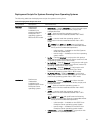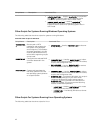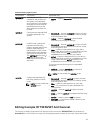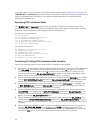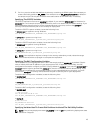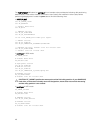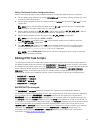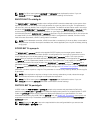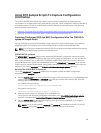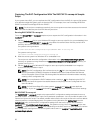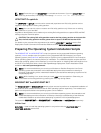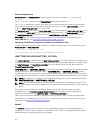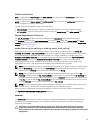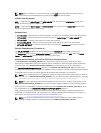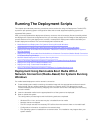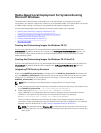
Using DTK Sample Scripts To Capture Configuration
Information
The SYSCFG and RACADM utilities can read the source system configuration and duplicate that
configuration on a target system using a sample DTK script file. These configuration files are used during
a full deployment to configure the BIOS, BMC, and RAC settings on the target system. The following
sections provide instructions for:
• Capturing The System BIOS And BMC Configuration With The SYSCAP Or syscap Sample Script
• Capturing The RAC Configuration With The RACCAP Or raccap Sample Script
Capturing The System BIOS And BMC Configuration With The SYSCAP Or
syscap.sh Sample Script
You can replicate the system BIOS and BMC configurations from a source Dell system to an identical
target Dell system. For example, from one PowerEdge R720 to another Dell PowerEdge R720.
NOTE: For the script to complete successfully, the source system must have access to the network
share that includes the pre-built DTK directory structure.
SYSCAP.BAT Or syscap.sh
The SYSCAP.BAT or syscap.sh sample script captures BIOS and BMC configuration settings and saves
them to a specified location. An optional user input can be passed as a parameter. You can provide the
path or file name as an input to this script. The default variable values used in this script are set to the
correct default values to perform a scripted deployment. The SYSCAP.BAT or syscap.sh script uses the
SYSCFG utility to retrieve BIOS and BMC configuration settings from the source system and to save the
settings in a file named syscfg.ini in the Z:\Dell\Toolkit\Systems\<target system> directory.
Running The SYSCAP.BAT Or Syscap.sh
To run the SYSCAP.BAT or syscap.sh sample script to capture the BIOS and BMC configuration
information in the syscfg.ini file:
1. Edit the startnet.cmd file (on your Windows PE image) or start-up script file (on your embedded Linux
image) to call the SYSCAP.BAT or syscap.sh script after the network share with the pre-built DTK
directory structure is mounted. For example, add:
On systems running Windows:
call Z:\Dell\Toolkit\Template\Scripts\SYSCAP.BAT
On systems running Linux:
/opt/dell/toolkit/template/scripts /syscap.sh
2. Boot the source system into Windows PE or embedded Linux.
The script runs and saves the configuration information in the \Toolkit\Systems\<target system>
directory in Windows and /opt/dell/toolkit/systems/<target system> directory in Linux.
3. Edit the startnet.cmd file (Windows PE image) or start-up script file (embedded Linux image) to
remove the text you added in step 1.
NOTE: For 9G or later systems, raccap.sh and syscap.sh have duplicate functions. If you run
raccap.sh followed by syscap.sh, the latter overwrites settings of the former.
49



